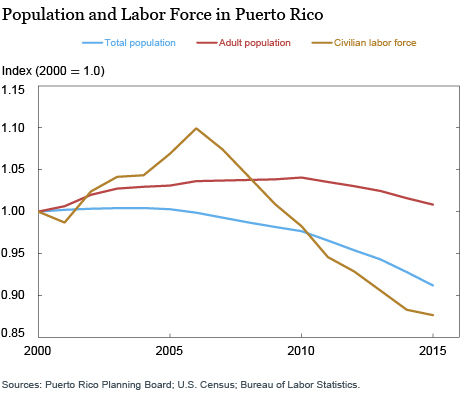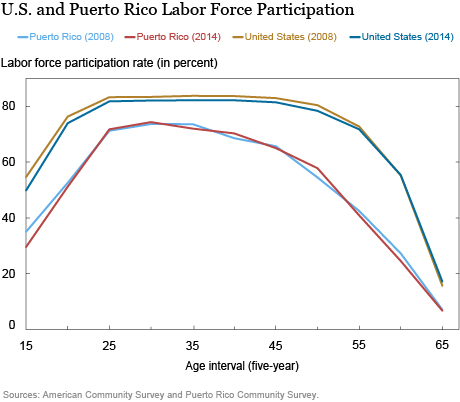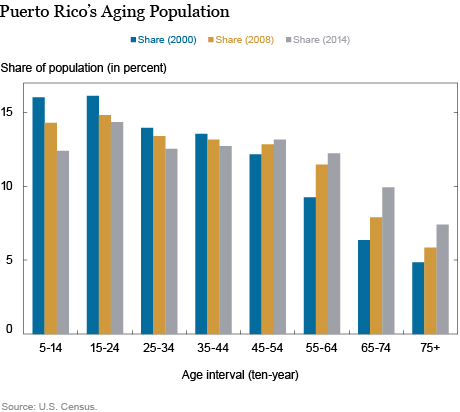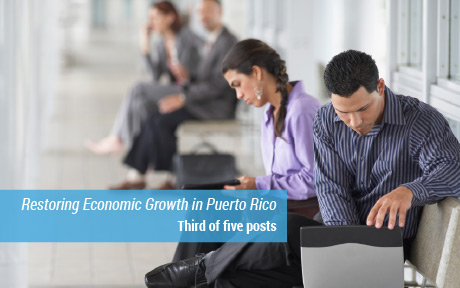A key concern about Puerto Rico’s prospects is that its labor force participation rate, which is the percentage of the adult population either working or looking for work, has fallen sharply. Looking at the data shows that this decline cannot be attributed to any particular demographic segment. Instead, it is the consequence of an aging population, accelerated by a falling birth rate and outmigration of a relatively young cohort. Expected demographic trends will continue to put downward pressure on the participation rate over the medium term, creating a challenging headwind for the economy to overcome.
The size of the labor force has declined much more sharply than the size of the adult population, reflecting falling labor force participation. The chart below shows trends in Puerto Rico’s labor force against its total population and adult population. While much has been made of the decline in Puerto Rico’s population since 2000, the decline in the adult population has been more modest, starting only in 2010. This fact can be explained by declining birthrates (so, fewer individuals moving into the adult population) and outmigration picking up in the post-2010 period. More dramatic, however, is the shrinking labor force: after increasing more than 10 percent from 2001 to 2006, Puerto Rico’s labor force has since plummeted 20 percent and stands at its lowest level in more than twenty-five years. Based on data from the Puerto Rico Planning Board, the labor force participation rate increased from 46 percent in 2000 to 49 percent in 2006, only to decline to 40 percent in 2014, where it has remained since. For reference, labor force participation has also declined in the U.S. mainland since 2006, but not nearly as sharply and from a significantly higher level—from 66 percent to 63 percent.

So how pervasive is this decline in the labor force participation rate? To examine this question, we rely on labor force data in the American Community Survey (ACS). This data set allows us to consider labor force participation by age. Note that methodologically consistent data from the ACS are only available back to 2008, when the questions on labor force status were modified. In the chart below, we plot labor force participation rates for the mainland and for Puerto Rico by age for two years: 2008 (the earliest comparable year) and 2014 (the most recent year available). It should be noted that the ACS tends to report higher levels of overall labor force participation for Puerto Rico than the Planning Board: for instance, the ACS estimates that labor force participation among all adults fell from 48 percent in 2008 to 45 percent in 2014, while the Planning Board reports that the rate fell from 46 percent to 40 percent. This discrepancy reflects a combination of methodological differences.

What is striking here is not only that labor force participation rates are substantially lower in Puerto Rico than on the mainland across all ages, but also that they start dropping off at a much earlier age. Another observation, more in tune with identifying the cause of Puerto Rico’s labor force participation decline, is that participation rates in Puerto Rico did not change much by age groups over this period. They did decline noticeably for people aged 15 to 19, but declined only modestly for those aged 55 and over.
The failure to pinpoint the source of the overall decline in the labor force participation rates suggests something else is at work, namely the aging of the population. That is, people are moving into age groups where the propensity to work tends to be lower. To that end, while the adult population has not declined significantly since 2000, its age composition has. The population 65 and older has increased substantially since 2000, while the population of young adults (15 to 24) has fallen. Moreover, the population age 5 to 14 (those coming of working age over the next decade) has fallen even more sharply. One factor is that Puerto Rico’s birth rate has tumbled by one third over the past fifteen years. This decline, coupled with a large outmigration of younger individuals that gained momentum in recent years, has shifted the composition of the Puerto Rico population fairly dramatically towards older cohorts. The chart below shows the shift in each age group’s share of the population from 2000 to 2014.

As shown earlier, labor force participation on the island starts dropping off noticeably after age 40. Thus, as more and more people move into these older age groups, fewer and fewer Puerto Ricans are likely to participate in the labor force—much more so than on the mainland, where participation stays fairly high until around age 55. This combination largely accounts for the sizable aggregate decline in Puerto Rico’s labor force participation.
To show how large this effect has been, we ask the counterfactual question, “What would have happened to the labor force participation rate if its age mix had not changed?” In contrast with the actual decline of 3.2 percentage points from 2008 to 2014, the counterfactual exercise estimates that labor force participation would have declined by a more moderate 0.7 percentage point.
As a final exercise, we project the future trajectory for labor force participation, based on changes in the age mix. Holding labor force participation rates within five-year age cohorts constant at their 2014 level, based on our population projections for each of these groups, we estimate that overall labor force participation will decline another 3 percentage points from 2014 to 2020 due purely to age effects. Migration among the young accelerates this process, so incentivizing young individuals to stay in Puerto Rico and encouraging them to participate in the labor force will be of vital importance to Puerto Rico’s efforts to get its economy back on track.
Disclaimer
The views expressed in this post are those of the authors and do not necessarily reflect the position of the Federal Reserve Bank of New York or the Federal Reserve System. Any errors or omissions are the responsibility of the authors.
 Jason Bram is a research officer in the Federal Reserve Bank of New York’s Research and Statistics Group.
Jason Bram is a research officer in the Federal Reserve Bank of New York’s Research and Statistics Group.
 Harry Wheeler is a senior research analyst in the Bank’s Research and Statistics Group.
Harry Wheeler is a senior research analyst in the Bank’s Research and Statistics Group.
How to cite this blog post:
Jason Bram and Harry Wheeler, “Puerto Rico’s Shrinking Labor Force Participation,” Federal Reserve Bank of New York Liberty Street Economics (blog), August 10, 2016, http://libertystreeteconomics.newyorkfed.org/2016/08/puerto-ricos-shrinking-labor-force-participation.html.











 RSS Feed
RSS Feed Follow Liberty Street Economics
Follow Liberty Street Economics